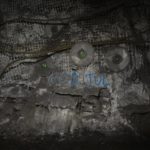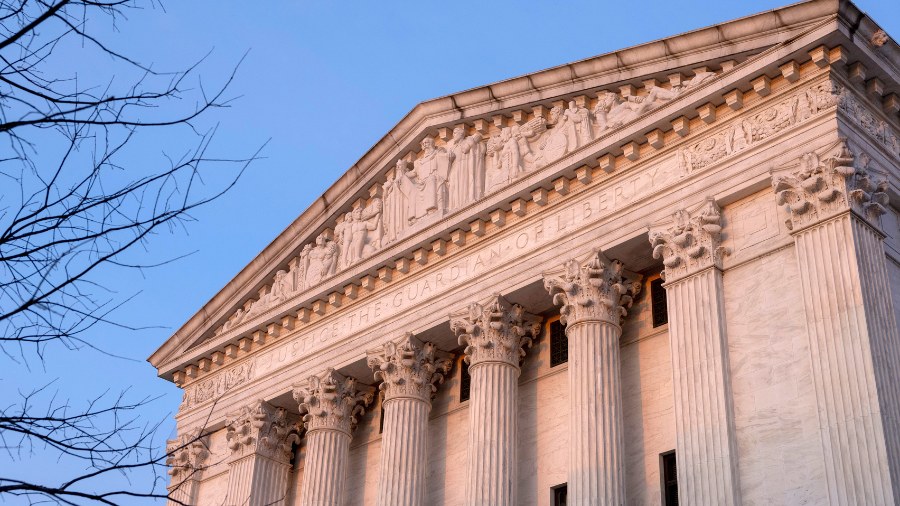Church helps mining community evolve in dark, warming Arctic
Jan 25, 2023, 3:30 PM | Updated: Jan 26, 2023, 5:38 am

The Rev. Siv Limstrand walks with her rifle to the church's cabin in Bolterdalen, Norway, Monday, Jan. 9, 2023. For the lone pastor in this fragile, starkly beautiful environment, the challenge is to fulfill the church's historical mission of ministering to those in crisis while addressing a pressing and divisive contemporary challenge. "We pray every Sunday for everyone who's affected by climate change," Limstrand said. (AP Photo/Daniel Cole)
(AP Photo/Daniel Cole)
LONGYEARBYEN, Norway (AP) — The warm glow of Svalbard Kirke’s lights gleams on the snow-covered mountain slope from where the church stands like a beacon over this remote Norwegian Arctic village, cloaked in the polar night’s constant darkness.
A century after it was founded to minister to the coal miners who settled Longyearbyen, the Lutheran house of faith is open 24/7, serving as a crucial gathering point for a community navigating a drastic change in its identity.
The last Norwegian coal mine in Svalbard – an archipelago that’s one of the world’s fastest warming spots – was slated to close this year and only got a reprieve until 2025 because of the energy crisis driven by the war in Ukraine.
For the lone pastor in this fragile, starkly beautiful environment, the challenge is to fulfill the church’s historical mission of ministering to those in crisis while addressing a pressing and divisive contemporary challenge.
“We pray every Sunday for everyone who’s affected by climate change,” the Rev. Siv Limstrand said. “We also have a role to play as church when it comes to thinking theologically, about what are we doing to the creation.”
On treeless land hemmed by glaciers, mountains and deep fjords, Longyearbyen is a town of visible paradoxes.
The open water of the rapidly warming sea laps up against old coal mining conveyors. Tourists come by the environmentally unfriendly planeload to seek pristine wilderness they can only explore with guides armed against polar bears.
Right below where the first mine was built, Svalbard Kirke beckons to its fireplace-warmed lounge that opens into the sanctuary. A cup of coffee or hymnbooks in multiple languages are always available – as long as visitors first remove their shoes in the entryway, as miners used to do with soot-covered boots.
“You don’t have to be very religious. They have room for everybody,” said Leonard Snoeks, whose daughter sings in Polargospel, the church’s children’s choir, and whose wife is working on the city’s transition to renewable energy.
The switch this year from coal-fired to diesel-powered energy production at the plant – which prompted the mine’s original decision to shut down – is expected to halve carbon dioxide emissions even as the search for long-term, cleaner alternatives continues, said Torbjørn Grøtte, Longyearbyen’s energy transition project leader.
As change swirls faster than the snowdrifts covering Longyearbyen’s few miles of paved roads, the church’s anchoring role seems poised to remain the only constant.
It attracts miners who have attended funerals for colleagues who died on the job over the decades, as well as newly arrived scientists and tourism workers seeking to integrate in the increasingly diverse community where people now tend to stay only a couple of years.
Store Norske, the Norwegian company still operating the remaining mine, built the first church in 1921 in Longyearbyen – which translates as “the town of Longyear,” the surname of the American who established the first mining operation here.
For decades, the town’s two supreme authorities were the mine’s executive and the church’s pastor, old-timers say.
The first pastor was also the teacher in the company town that for most of the 20th century was inhabited by single miners and the mining executives’ families. Outside town limits, a few trappers continued to hunt, a long tradition in these glacier-covered islands.
Miners and their families also made up the Russian towns in Svalbard. At the surviving one, Barentsburg, coal is still extracted under a century-old international treaty that grants rights to all signatory countries. Relations with Longyearbyen, which had normalized after the end of the Cold War as miners traded visits by boat and snowmobile, have been strained again by Russia’s invasion of Ukraine nearly a year ago.
Trond Johansen was 17 when he arrived in Longyearbyen in 1971 on a plane chartered by the mining company that landed on an ice field – the airport would be built a few years later.
Sipping black coffee on a mid-January morning in the town’s sleek café that offers knitted wear and artisanal chocolates, the retired miner recalled when the main entertainment was at the church.
Before TVs, let alone anything like the plush cinema soon to open in the town’s new art gallery, Johansen and fellow miners gathered on Wednesdays to watch four-week-old videocassettes of news broadcasts from the mainland – though they skipped over the weather forecast, Johansen added with a chuckle.
“It was a fantastic place to grow up, more free probably than many places, and you had the wild and the excitement with polar bears lurking around,” said Bent Jakobsen, who was born on Svalbard and works at the Norwegian coal mine like his father and brothers before him.
But today he jokes the mine’s closing will turn him into an endangered species just like the iconic Arctic predator.
“I can be stuffed and put in the museum, me and the polar bear,” Jakobsen said.
Svalbard’s natural environment has been changing fast, too. There’s no more ice on Isfjorden, which translates as “ice fjord” and whose feet-thick ice cover used to be traversed by polar bears in winter until a dozen years ago.
“Everything except the darkness has changed,” said Kim Holmén, a special advisor to the Norwegian Polar Institute who has researched climate in Svalbard for decades. At this latitude, only the January moon glows around the clock.
Swept by the Gulf Stream ocean current and increasingly surrounded by open water, which accelerates heating, Svalbard is warming even faster than the rest of the Arctic, according to both Holmén and data from the Norwegian Meteorological Institute.
Compared to the 1961-1990 normal, winter temperatures of the last decade averaged 7.3 degrees Celsius (13.2 degrees Fahrenheit) warmer. It’s been a dozen years since Svalbard hit -30 degrees Celsius (-22 degrees Fahrenheit), which used to happen regularly decades ago.
“Plants, animals, birds, the whole ecosystem is changing,” Holmén added, as cold-adjusted species struggle and new ones arrive.
Unusual winter rains unsettle the snowpack, which has led to more avalanches, including a deadly one a few days before Christmas in 2015 that ripped through town, killing two people.
One of them was a friend of Svalbard Kirke’s then-pastor, the Rev. Leif Magne Helgesen, who had already been working on raising awareness of the changes he was observing on the island.
“As a pastor on Svalbard, you’re the northernmost religious leader in the world. That gives you a pulpit,” Helgesen said.
“There are three main ethical challenges we need to deal with and have a prophetic voice in the church: Poverty, conflict, and climate,” he added. “It’s hypocritical to only talk about life after death. We also strongly believe in life on earth and life today.”
He started including prayers about climate in regular worship services. He also worked with the church’s then music director, Espen Rotevatn, to create vocals and instrumentals for a climate change Mass – including a rite of penance for piano with deep, haunting notes and upbeat, Blues-inspired passages.
“Some lyrics are dark, but much of it is filled with hope,” said Rotevatn. He has been lobbying for the mine to close, which he said was a very unpopular cause just a few years ago.
From a Christian perspective, some might argue that God can fix everything – but Rotevatn shares a different view he believes is more common in the Norway’s churches.
“We have a responsibility for the earth that is given to us, to (not) destroy it, which is what we may be doing now,” he said.
Rotevatn is now the principal of Svalbard Folkehøgskole, an alternative higher-ed institution in Longyearbyen that he hopes to run as “green” as possible, including with solar panels. For several months in the spring and summer, the sun never sets in Svalbard, just like it never rises in winter.
In that constant darkness, keeping a light burning becomes more than a metaphor for Svalbard Kirke.
“Physical openness and accessibility to me not only symbolizes, but it is also … an ideal for what a church should be,” said Limstrand, who became pastor here in 2019, nearly thirty years after her ordination. “People can come in totally on their own terms.”
Among a couple dozen congregants at a mid-January Sunday afternoon Mass was a Hindu family from the Indian state of Uttar Pradesh – two scientists and their 18-month-old daughter, whom they named Svalbie after the archipelago.
“God is God, it doesn’t matter which religion. We feel good, peaceful and calm, similar to how we feel when we go to temple,” said environmental chemist Neelu Singh.
She and Svalbie started coming to church for the weekly “baby song hour.” To the church piano’s accompaniment, new parents sing to their babies in a circle before sharing lunch with the pastor and church staff.
“You feel connected with the community and get a chance to be social,” said Singh, who believes hers was the only Indian family in Longyearbyen when they moved here four years ago.
What Limstrand calls “spiritual hospitality” also extends outwards from the red-slatted church.
Before the pandemic, she hosted regular visits by Catholic and Orthodox priests to minister to their congregations – including Poles at remote research stations, Russians and Ukrainians in Barentsburg, and a few Filipino workers at the town’s only supermarket who happily reminisced recently about those moments.
The pastor herself travels to celebrate services beyond the church – including once at Green Dog, a dogsledding outfit half a dozen miles from Longyearbyen in a broad valley.
“How many priests can you ask to come to a dog yard in -11 (degrees Celsius, 12 degrees Fahrenheit) to baptize two kids?” said their mother, Karina Bernlow, who runs Green Dog with her husband and arrived in Svalbard 11 years ago after a stint in Greenland.
In this time, Bernlow has already seen Longyearbyen transform from a community where mining families lived for generations and extended a warm welcome to outsiders, to a mix of short-term workers who hardly ever meet outside their jobs.
“A place without history, that’s what it’s turning into. I can see how it’s disappearing,” she said as the wind, and the dogs, howled outside a log cabin near her yard. Bright lights marked the entrance to the last Norway-operated mine on the opposite mountainside.
“The church is a bridge-builder. A place like this, with so many nationalities, it’s really important to have,” she added. “I don’t go to church very often, but I know it’s there if I need it.”
That is exactly the kind of church Limstrand wants to foster in order to serve this changing community.
Here, people feel at home when they come to worship by the rose-filled altar, because they have already attended a concert, or a community gathering, or the Tuesday night coffee hour, when hot-off-the-griddle waffles are smothered in brunost, Norway’s traditional caramel-tasting cheese.
“It’s not the pastor’s church, it’s not the Church’s church, it’s not the church council’s church, but it’s our church,” Limstrand said. “It’s something that is shared, it’s not something that is guarded.”
___
Associated Press religion coverage receives support through the AP’s collaboration with The Conversation US, with funding from Lilly Endowment Inc. The AP is solely responsible for this content.
__
Associated Press climate and environmental coverage receives support from several private foundations. See more about AP’s climate initiative here. The AP is solely responsible for all content.
Copyright © The Associated Press. All rights reserved. This material may not be published, broadcast, rewritten or redistributed.



































